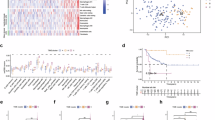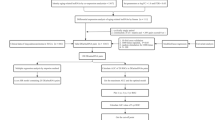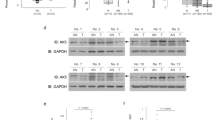Abstract
Background:
Diagnosis of adrenocortical neoplasms (ACN), in pediatric age, is based on Wieneke criteria. The p57, a cyclin-dependent kinase inhibitor, acts to negatively regulate cell proliferation and is frequently found dysregulated in cancer. The identification of loss of heterozygosity (LOH) of 11p15, containing the p57 gene, could be a tool for differential diagnosis of benign and malignant ACN.
Methods:
Immunohistochemistry with anti-p57 and microsatellite markers analysis of 11p15 region to value LOH were made in both ACN and surrounded normal adrenal cortex.
Results:
Nine ACN, two clinically benign, two uncertain, and five malignant, were diagnosed. Positive p57 cells were evident in normal adrenal cortex and in one histologically benign ACN. A low/absent expression of p57 was documented in eight ACN independently from the classification on the basis of pathological and clinical criteria. Microsatellite marker analysis confirmed the LOH of 11p15 region in the same ACN.
Conclusion:
LOH of 11p15 has a high prognostic value suggesting the p57 gene is important in ACN pathogenesis. Immunohistochemistry for p57 is a simple and cheap tool that can be used to quickly identify LOH of 11p15 in ACN.
Similar content being viewed by others
Log in or create a free account to read this content
Gain free access to this article, as well as selected content from this journal and more on nature.com
or
References
Faria AM, Almeida MQ. Differences in the molecular mechanisms of adrenocortical tumorigenesis between children and adults. Mol Cell Endocrinol 2012;351:52–7.
Michalkiewicz E, Sandrini R, Figueiredo B, et al. Clinical and outcome characteristics of children with adrenocortical tumors: a report from the International Pediatric Adrenocortical Tumor Registry. J Clin Oncol 2004;22:838–45.
Barlaskar FM, Hammer GD. The molecular genetics of adrenocortical carcinoma. Rev Endocr Metab Disord 2007;8:343–8.
Sidhu S, Gicquel C, Bambach CP, et al. Clinical and molecular aspects of adrenocortical tumourigenesis. ANZ J Surg 2003;73:727–38.
Bourcigaux N, Gaston V, Logié A, Bertagna X, Le Bouc Y, Gicquel C. High expression of cyclin E and G1 CDK and loss of function of p57KIP2 are involved in proliferation of malignant sporadic adrenocortical tumors. J Clin Endocrinol Metab 2000;85:322–30.
Matsuoka S, Thompson JS, Edwards MC, et al. Imprinting of the gene encoding a human cyclin-dependent kinase inhibitor, p57KIP2, on chromosome 11p15. Proc Natl Acad Sci USA 1996;93:3026–30.
Barzon L, Chilosi M, Fallo F, et al. Molecular analysis of CDKN1C and TP53 in sporadic adrenal tumors. Eur J Endocrinol 2001;145:207–12.
Gicquel C, Bertagna X, Gaston V, et al. Molecular markers and long-term recurrences in a large cohort of patients with sporadic adrenocortical tumors. Cancer Res 2001;61:6762–7.
Wieneke JA, Thompson LD, Heffess CS. Adrenal cortical neoplasms in the pediatric population: a clinicopathologic and immunophenotypic analysis of 83 patients. Am J Surg Pathol 2003;27:867–81.
Kassem SA, Ariel I, Thornton PS, et al. p57(KIP2) expression in normal islet cells and in hyperinsulinism of infancy. Diabetes 2001;50:2763–9.
Weiss LM, Medeiros LJ, Vickery AL Jr . Pathologic features of prognostic significance in adrenocortical carcinoma. Am J Surg Pathol 1989;13:202–6.
Dehner LP, Hill DA. Adrenal cortical neoplasms in children: why so many carcinomas and yet so many survivors? Pediatr Dev Pathol 2009;12:284–91.
Dall’Igna P, Virgone C, De Salvo GL, et al. Adrenocortical tumors in Italian children: analysis of clinical characteristics and P53 status. Data from the national registries. J Pediatr Surg 2014;49:1367–71.
Magro G, Esposito G, Cecchetto G, et al. Pediatric adrenocortical tumors: morphological diagnostic criteria and immunohistochemical expression of matrix metalloproteinase type 2 and human leucocyte-associated antigen (HLA) class II antigens. Results from the Italian Pediatric Rare Tumor (TREP) Study project. Hum Pathol 2012;43:31–9.
Peixoto Lira RC, Fedatto PF, Marco Antonio DS, et al. IGF2 and IGF1R in pediatric adrenocortical tumors: roles in metastasis and steroidogenesis. Endocr Relat Cancer 2015;23:481–93.
Leite FA, Lira RC, Fedatto PF, et al. Low expression of HLA-DRA, HLA-DPA1, and HLA-DPB1 is associated with poor prognosis in pediatric adrenocortical tumors (ACT). Pediatr Blood Cancer 2014;61:1940–8.
Dias AI, Fachin CG, Avó LR, et al. Correlation between selected angiogenic markers and prognosis in pediatric adrenocortical tumors: Angiogenic markers and prognosis in pediatric ACTs. J Pediatr Surg 2015;50:1323–8.
Rainey WE, Carr BR, Wang ZN, Parker CR Jr . Gene profiling of human fetal and adult adrenals. J Endocrinol 2001;171:209–15.
Leboulleux S, Gaston V, Boulle N, Le Bouc Y, Gicquel C. Loss of heterozygosity at the mannose 6-phosphate/insulin-like growth factor 2 receptor locus: a frequent but late event in adrenocortical tumorigenesis. Eur J Endocrinol 2001;144:163–8.
Lalli E, Figueiredo BC. Pediatric adrenocortical tumors: what they can tell us on adrenal development and comparison with adult adrenal tumors. Front Endocrinol (Lausanne) 2015;6:23.
Acknowledgements
The authors thank Marta Stefanelli for IHC and Gabriele Bacile for his assistance with the figures.
Author information
Authors and Affiliations
Corresponding author
PowerPoint slides
Rights and permissions
About this article
Cite this article
Giovannoni, I., Boldrini, R., Benedetti, M. et al. Pediatric adrenocortical neoplasms: immunohistochemical expression of p57 identifies loss of heterozygosity and abnormal imprinting of the 11p15.5. Pediatr Res 81, 468–472 (2017). https://doi.org/10.1038/pr.2016.239
Received:
Accepted:
Published:
Issue date:
DOI: https://doi.org/10.1038/pr.2016.239



